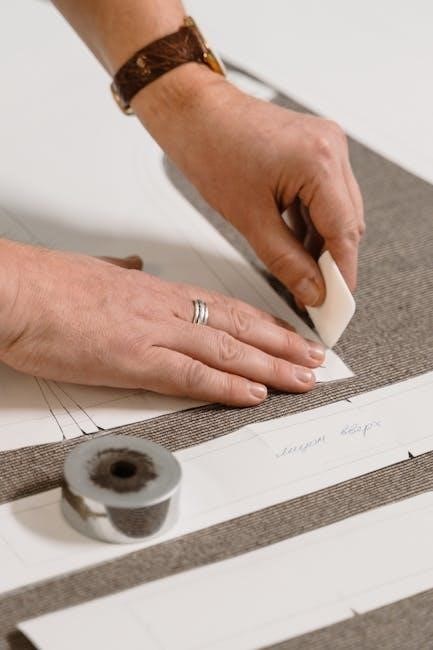Understanding shirt measurements is essential for ensuring a perfect fit. Accurate measurements of the neck‚ chest‚ waist‚ and sleeves guarantee comfort and style. Learn how to measure correctly for the best results.
Why Accurate Measurements Matter
Accurate shirt measurements are crucial for achieving the perfect fit‚ ensuring both comfort and style. A well-fitted shirt enhances your professional appearance and confidence. Ill-fitting shirts can feel restrictive or overly loose‚ affecting your overall comfort and the way the garment drapes on your body. Proper measurements also prevent the need for costly alterations. Understanding ease‚ the additional space built into garments for movement‚ is key to avoiding shirts that are too tight or boxy. By measuring your neck‚ chest‚ waist‚ and sleeves correctly‚ you can choose a size that aligns with your body proportions. This ensures the shirt sits smoothly across your chest‚ shoulders‚ and waist‚ creating a polished look. Taking the time to measure accurately guarantees a tailored fit‚ making your shirt look and feel its best. Always use a flexible tape measure and consult a size chart for the most reliable results.
Key Measurements to Consider
When measuring for a shirt‚ focus on four key areas: neck circumference‚ chest width‚ waist size‚ and sleeve length. The neck measurement determines the collar fit‚ ensuring comfort and preventing the shirt from being too tight or loose. Chest measurement is taken with the tape measure placed under the armpits and around the broadest part of the chest‚ ensuring the shirt buttons comfortably. Waist measurement is taken at the narrowest point of your natural waistline‚ typically just above the hipbone‚ to ensure a flattering fit. Sleeve length is measured from the center back of the neck‚ over the shoulder‚ and down to the wrist‚ ensuring the cuffs sit correctly. These measurements are essential for selecting the right size from a shirt size chart‚ ensuring a balanced and proportional fit. Accurate measurements in these areas ensure the shirt drapes well and provides maximum comfort throughout the day.

Understanding Shirt Fit Types
Shirts come in slim‚ regular‚ and tailored fits‚ each offering a unique balance of comfort and style. Slim fit is tight‚ regular fit is relaxed‚ and tailored fit is customized for precision.
Slim Fit vs. Regular Fit
Slim-fit shirts are designed to hug the body closely‚ offering a modern and streamlined appearance. They are ideal for those with a lean build or who prefer a fashionable‚ tailored look without excess fabric. In contrast‚ regular-fit shirts provide a more relaxed silhouette‚ offering ease of movement and comfort. They are perfect for individuals who value practicality while maintaining a classic style. The key difference lies in measurements‚ with slim-fit shirts having reduced chest‚ waist‚ and sleeve room compared to regular-fit options. Understanding these distinctions helps in selecting the right fit based on personal preference and body type. Always refer to a size chart to ensure accuracy‚ as measurements can vary between brands. Choosing the correct fit enhances both comfort and confidence‚ making it essential to consider these factors when selecting a shirt.
Tailored Fit and Its Benefits
A tailored fit shirt offers a balance between slim and regular fits‚ providing a polished‚ professional appearance. It is designed to skim the body‚ creating a streamlined look without being overly tight. The tailored fit is ideal for those seeking a classic style with modern aesthetics‚ ensuring ease of movement while maintaining a sharp silhouette. This fit is particularly beneficial for individuals with athletic builds or those who prefer a more refined look. The tailored fit emphasizes precision in measurements‚ ensuring the shirt complements the wearer’s physique. Unlike slim-fit shirts‚ it offers slightly more room through the chest and waist‚ while still maintaining a structured appearance. The key benefit lies in its versatility‚ making it suitable for both formal and casual occasions. By choosing a tailored fit‚ you achieve a balance between style and comfort‚ ensuring a flattering and professional look in any setting.

How to Measure Your Shirt
Measuring your shirt involves assessing key areas like neck circumference‚ chest width‚ waist‚ and sleeve length. Use a flexible tape measure and follow a guide to ensure accuracy and the best fit.

Measuring the Neck Circumference
Measuring the neck circumference is the first step in determining your shirt size. Place the tape measure around the base of your neck‚ just below the Adam’s apple‚ with one finger inserted for comfort. Ensure the tape is level and not too tight or loose. This measurement corresponds to the shirt’s collar size. For the most accurate fit‚ add half an inch to your neck measurement to account for ease. This ensures the collar won’t be too restrictive. Proper neck measurement is crucial as it directly affects the overall comfort and appearance of the shirt. By following this simple process‚ you can ensure a comfortable and tailored fit for any dress or casual shirt.
Calculating Chest and Waist Measurements
To determine your chest measurement‚ place the tape measure around the widest part of your chest‚ keeping it level and parallel to the floor. Ensure the tape is not too tight or loose. For an accurate fit‚ double the measurement taken from one side of the chest to the other‚ as this accounts for the full circumference. Similarly‚ measure your natural waistline‚ which is the narrowest point of your torso‚ usually just above the hipbone. For shirts‚ the waist measurement is crucial for achieving a tailored look. When measuring‚ keep the tape measure level and avoid pulling it too tight. Proper chest and waist measurements ensure the shirt fits comfortably without being too snug or loose. These measurements are essential for selecting the correct size from a shirt size chart‚ ensuring both style and comfort.
Determining Sleeve Length and Body Length
Measuring sleeve length involves starting from the center back of the neck‚ just below the collar‚ and extending over the shoulder to the cuff. This ensures the sleeve fits comfortably. For body length‚ measure from the yoke (the piece across the shoulders) down to the hem. Using a flexible tape measure is crucial for accuracy. Ensure the tape isn’t too tight or loose. Consider ease‚ the extra space added for comfort and movement. Sleeve length typically varies by arm length‚ while body length averages around 29-30 inches for a medium. Measurements can be taken with the shirt laid flat or while wearing it for a better fit. Standard measurements for sizes should be referenced for accuracy. Precise measurements ensure the shirt fits well‚ whether slim fit or regular. This process guarantees a comfortable and stylish fit for any shirt style.

Common Mistakes in Shirt Measurements
Common mistakes include ignoring ease‚ not using a flexible tape measure‚ and incorrect placement of the tape. These errors lead to poor fit and discomfort. Avoid them for accurate results.

Ignoring the Importance of Ease
One of the most common mistakes in shirt measurements is ignoring the importance of ease. Ease refers to the extra space built into a shirt beyond your body measurements‚ ensuring comfort and mobility. Without proper ease‚ a shirt can feel restrictive and tight‚ limiting movement and creating an uncomfortable fit; Many people overlook this factor‚ assuming that tight measurements translate to a perfect fit. However‚ shirts are designed with ease in mind to accommodate natural body contours and allow for a full range of motion. Neglecting ease can result in a shirt that pulls at the seams or feels constricting‚ especially around the chest and shoulders. To avoid this‚ always refer to size charts that include ease measurements‚ ensuring your shirt has the right balance of fit and comfort. This step is crucial for achieving a shirt that looks and feels great. Proper ease ensures a polished‚ professional appearance without sacrificing comfort.

Not Using a Flexible Tape Measure
One of the most critical errors in shirt measurements is not using a flexible tape measure. A flexible tape measure is essential for accurately capturing body contours‚ as it can conform to the natural curves of your neck‚ chest‚ and waist. Using a rigid or non-flexible tool often leads to inaccurate measurements‚ as it cannot properly follow the shape of your body. This can result in a shirt that fits poorly‚ either too tight or too loose in specific areas. For instance‚ measuring the neck circumference requires a tape measure that can wrap snugly around it without digging in or slipping. Similarly‚ chest and waist measurements need a flexible tool to ensure the tape lies flat and follows the body’s natural shape. Always invest in a high-quality‚ flexible tape measure to achieve precise and reliable results for the best fit. This simple step can make a significant difference in the comfort and appearance of your shirt.

Using a Size Chart for Accuracy
A size chart helps ensure the perfect fit by comparing your measurements to standard sizes. Match your neck‚ chest‚ and sleeve measurements to the chart for accurate sizing and optimal comfort.
How to Read a Shirt Size Chart
Reading a shirt size chart involves matching your body measurements to the corresponding sizes. Start by identifying your neck circumference‚ as it is often the primary measurement for dress shirts. Next‚ locate your chest measurement‚ ensuring it aligns with the chart’s guidelines. Sleeve length is typically measured from the center back of the neck to the wrist. Compare these measurements to the chart to determine the best fit. Pay attention to ease‚ as shirts usually have an additional 8 inches of ease over body measurements. Regular and slim fits may vary slightly‚ so double-check the specific fit type. Using a flexible tape measure ensures accuracy. If you’re between sizes‚ consider sizing up for comfort. This method guarantees a tailored fit‚ enhancing both appearance and comfort.
Comparing Measurements to Ensure the Best Fit
Comparing your measurements to a shirt size chart ensures a perfect fit. Start by matching your neck circumference to the chart‚ as this is often the base for sizing. Next‚ align your chest measurement with the chart‚ considering the ease added to shirt sizes. Sleeve length should be measured from the center back of the neck to the wrist‚ ensuring it matches the chart’s specifications. Body length‚ measured from the top of the shoulder to the hem‚ should also align with the chart. Regular and slim fits vary slightly‚ so verify the fit type you prefer. Use a flexible tape measure for accuracy and consider the ease built into shirts‚ typically 8 inches over body measurements. If your measurements fall between sizes‚ choose the next size up for comfort. This comparison method ensures a tailored fit‚ balancing style and comfort seamlessly.
